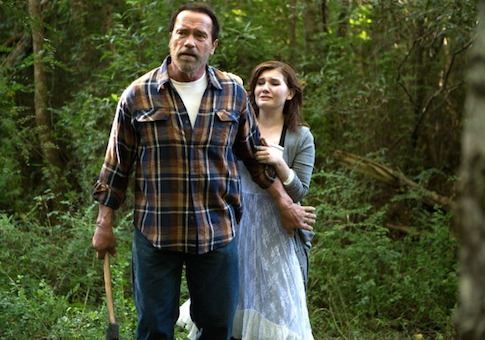Maggie opens with Wade (Arnold Schwarzenegger) searching a ruined American city for his daughter. In snippets of overheard radio chatter and newspaper headlines, we gather that a virus that turns people into zombies has overrun the world. The disease acts slowly; on average it takes eight weeks for the infected to turn into the undead.
Wade gets a call from the doctors. Apparently his girl, Maggie (Abigail Breslin), has been put into a shelter for the infected. She is in the early stages: a bit pale, a little light sensitive. But nothing like the ravenous cannibal Wade finds in an abandoned gas station, hungry for human flesh. Not yet, anyway.
The America of Maggie is on the brink of collapse. Crops are dying, possibly as a result of the necroambulist virus, and farmers like Wade are torching their fields in a last ditch effort to control the outbreak. But the crops are just a symbol of larger breakdown: everything in Maggie is failing. The power is out and social order is disintegrating. Martial law has been implemented, and local cops are empowered to take those with the disease to quarantine centers.
Said centers are places of horror for the infected. A teenage friend of Maggie’s says his uncle works at one of the quarantines; despite claims to the contrary by authorities, they are pits of sorrow where the fully infected chow down on those with early-stage symptoms.
Wade will not send Maggie to such a place. So they wait. And wait. While we watch. And watch.
Not very much actually happens in Maggie. Director Henry Hobson and John Scott 3 trade drama for mood, allowing the tension to grow and sadness to creep in as we watch Maggie for signs of decay and wait for Wade’s resolve to break. In that, Maggie reminds me somewhat of Kairo (2001), Kiyoshi Kurosawa’s J-horror flick about an Internet-based ghost-monster that sucks the will to live out of its victims and reduces their bodies to dusty husks.
Still, Maggie is never dull, exactly, because it’s so beautifully shot. Hobson and director of photography Lukas Ettlin make excellent use of natural lighting to create a mood of disaster and despair, shooting Schwarzenegger in silhouette as his crops burn and constantly filming from behind and below to frame the father and daughter with a bleak, gray, ominous sky.
If you’re going for "zombie tone poem," though, I’m not entirely convinced that Arnold should be the guy to play your lead. I love Schwarzenegger and have greatly enjoyed his run of post-governator films. And there are times when his turn as the sad-faced giant forced to grapple with the fact that he’s going to either have to send his daughter to a camp or put her down himself works. But on the occasions when the façade slips—when he throws in an exaggerated eye-roll or headshake—the illusion breaks.
Should you see it? Well, Maggie calls to mind what might happen if you asked Terrence Malick to remake Old Yeller and replaced the dog with a zombie daughter. I’m not entirely sure if that description is a compliment or a complaint. This movie is aimed at a very specific sort of audience. You’ll know better than I if you’re part of it.
